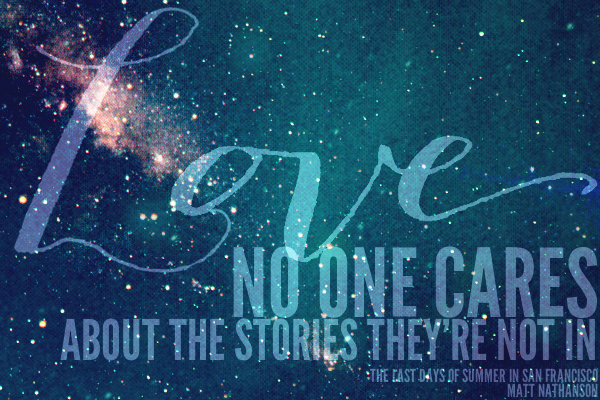The Stories They’re Not In
By Jessica Albon

The last few days, I’ve been listening to Matt Nathanson’s new album The Last Great Pretender a lot and there’s a line from The Last Days of Summer in San Francisco that keeps jumping out at me. The line goes, “Love, no one cares about the stories they’re not in.”
The reason it jumps out at me is because it’s such common marketing advice, right? You’re advised at all times to keep your focus exclusively on “What’s in it for them.” (Them being your audience.) You must never just tell a story for the sake of telling a story…
I think this is truly terrible advice. Read on to find out why…
The classic WIIFM marketing acronym (“What’s in it for me?”) gets tossed around a lot. And I get it–it’s catchy and does matter (sort of). So much marketing is about stuff the customer is never going to care about, and many companies could do with more focus on their customers and less focus on their processes.
But just like most pieces of marketing advice, this one can be taken way too far. And often is.
When you let it tie you up and worry, “But will they care about this?” about everything you think about sharing… it’s time to throw WIIFM out the window.
Because, at the end of the day, it’s not really about WIIFM. That’s not actually what your readers care about. Rather, what they want is context.
They don’t need everything you share to have a clear and compelling advantage for them. They need to understand why it matters–to either them or to you.
There’s so much information out there (duh!) that we all need support sorting through it. And making WIIFM clear to your reader is one way to help them sort. But it’s only one.
If it’s the only one you’re using, you’re missing out. Because keeping the focus 100% of the time on your reader or your customer or your prospect is just as one-sided as keeping the focus 100% of the time on you or your company or what you do.
And seeing as we’re building relationships here, we aren’t looking for one-sided.We’re looking for give and take, getting to know one another and building trust.
That doesn’t happen when you’re all WIIFM all the time. Anymore than it happens when you’re all “blah blah blah widgets” all the time. (Ahem: it *never* happens when you’re all “blah blah blah widgets” all the time…)
How do you know if your focus is too WIIFM? Ask yourself these questions:
- When’s the last time a reader emailed you out of the blue? Just to check in, chat, or share something? (Not to ask you a question or respond to your latest article.)
- What’s your sense of things? Do you feel like you’re focusing too much on WIIFM?
- Are you feeling a little resentful, like you aren’t getting enough out of the relationship you’re building with your customers, readers, or tribe?
If you’re not happy with your answers to these questions (and my guess is, if you’re doing WIIFM “right,” you won’t be), here are some ways to make what you’re sharing less all WIIFM all the time:
- Share something that’s important to you that will only be important to your readers *because* it’s important to you. (And make sure to tell your readers that it’s important to you–and why, perhaps.)
- Put your readers *in* your stories. There are two ways to think about the line, “no one cares about the stories they’re not in.” One is that people don’t care about the story if they weren’t there. But the other is that people don’t care about the stories they can’t imagine themselves in. When you make your stories come to life, your readers will feel like a part of them and they’ll care more.
- Remember, practice makes perfect. Just like WIIFM was probably an uncomfortable way to think at first, broadening your focus out from WIIFM is going to be uncomfortable too. That’s okay! Take it slow, and just remind yourself you’re practicing here. It’ll get easier over time.
It’s certainly true that your readers don’t want to hear you drone on about your blah, blah, blah widgets, but make sure you’re not taking the WIIFM marketing advice too seriously–just like most marketing advice, it’s all about finding your balance. What’s more, when you apply WIIFM too liberally, you run the risk of making what could be a relationship between you and your Tribe into something really one-sided where it’s all about the reader, all the time.
It’s okay (and even good!) to tell the stories that your readers aren’t in–don’t for one second think they won’t care. You just have to take the right approach.
Blog






